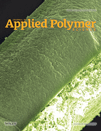Polymeric homogeneous composite membranes for separations in organic solvents
Abstract
A new generation of organic solvent nanofiltration (NF) composite membranes was prepared combining a support layer with a selective layer made both from the same polymeric material (P84 copolyimide). These membranes, homogeneous in composition, but composite in structure, were defined as polymeric homogeneous composite (PHC) membranes. The composite membranes have the advantage over the asymmetric ones that each layer can be optimized independently. Moreover, the use of the same material for the preparation of both, the selective and the support layer, ensures a high affinity between the two layers and increases the long-term stability of the composite membranes, reducing the possibility of delamination phenomena. In the design of the PHC membranes, a great attention was devoted to the support layer development. The effects of the composition of the casting solutions on the structure of porous P84 copolyimide membranes were investigated allowing to identify the conditions for the preparation of highly permeable, chemically, and mechanically stable P84 sponge like porous membranes. PHC membranes were prepared by coating and controlled solvent evaporation of a P84 solution on the optimized support crosslinked by reaction with a diamine (1,5-diamino-2-methylpentane). Pure solvent permeation test and rejection experiments were carried out on the P84 supports and the corresponding PHC membranes in aggressive organic solvents like N-methyl-2-pyrrolidone and N,N-dimethyformamide, in which the original polymer was soluble. The PHC membrane resulted completely stable over long times (>96 h). © 2012 Wiley Periodicals, Inc. J. Appl. Polym. Sci., 2013




